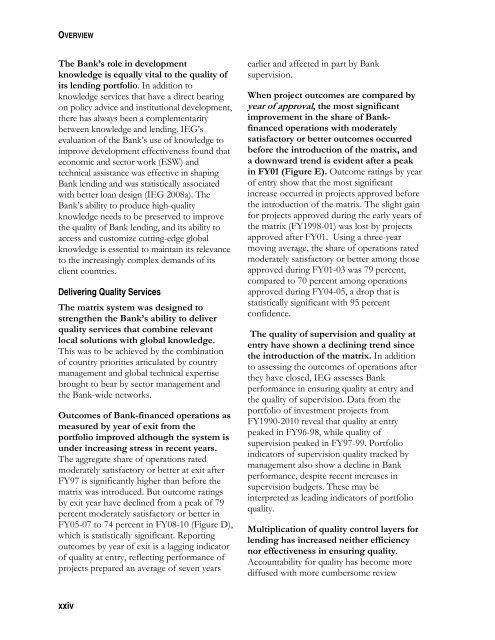The Matrix System at Work - Independent Evaluation Group - World ...
The Matrix System at Work - Independent Evaluation Group - World ...
The Matrix System at Work - Independent Evaluation Group - World ...
You also want an ePaper? Increase the reach of your titles
YUMPU automatically turns print PDFs into web optimized ePapers that Google loves.
OVERVIEW<br />
<strong>The</strong> Bank’s role in development<br />
knowledge is equally vital to the quality of<br />
its lending portfolio. In addition to<br />
knowledge services th<strong>at</strong> have a direct bearing<br />
on policy advice and institutional development,<br />
there has always been a complementarity<br />
between knowledge and lending. IEG’s<br />
evalu<strong>at</strong>ion of the Bank’s use of knowledge to<br />
improve development effectiveness found th<strong>at</strong><br />
economic and sector work (ESW) and<br />
technical assistance was effective in shaping<br />
Bank lending and was st<strong>at</strong>istically associ<strong>at</strong>ed<br />
with better loan design (IEG 2008a). <strong>The</strong><br />
Bank’s ability to produce high-quality<br />
knowledge needs to be preserved to improve<br />
the quality of Bank lending, and its ability to<br />
access and customize cutting-edge global<br />
knowledge is essential to maintain its relevance<br />
to the increasingly complex demands of its<br />
client countries.<br />
Delivering Quality Services<br />
<strong>The</strong> m<strong>at</strong>rix system was designed to<br />
strengthen the Bank’s ability to deliver<br />
quality services th<strong>at</strong> combine relevant<br />
local solutions with global knowledge.<br />
This was to be achieved by the combin<strong>at</strong>ion<br />
of country priorities articul<strong>at</strong>ed by country<br />
management and global technical expertise<br />
brought to bear by sector management and<br />
the Bank-wide networks.<br />
Outcomes of Bank-financed oper<strong>at</strong>ions as<br />
measured by year of exit from the<br />
portfolio improved although the system is<br />
under increasing stress in recent years.<br />
<strong>The</strong> aggreg<strong>at</strong>e share of oper<strong>at</strong>ions r<strong>at</strong>ed<br />
moder<strong>at</strong>ely s<strong>at</strong>isfactory or better <strong>at</strong> exit after<br />
FY97 is significantly higher than before the<br />
m<strong>at</strong>rix was introduced. But outcome r<strong>at</strong>ings<br />
by exit year have declined from a peak of 79<br />
percent moder<strong>at</strong>ely s<strong>at</strong>isfactory or better in<br />
FY05-07 to 74 percent in FY08-10 (Figure D),<br />
which is st<strong>at</strong>istically significant. Reporting<br />
outcomes by year of exit is a lagging indic<strong>at</strong>or<br />
of quality <strong>at</strong> entry, reflecting performance of<br />
projects prepared an average of seven years<br />
earlier and affected in part by Bank<br />
supervision.<br />
When project outcomes are compared by<br />
year of approval, the most significant<br />
improvement in the share of Bankfinanced<br />
oper<strong>at</strong>ions with moder<strong>at</strong>ely<br />
s<strong>at</strong>isfactory or better outcomes occurred<br />
before the introduction of the m<strong>at</strong>rix, and<br />
a downward trend is evident after a peak<br />
in FY01 (Figure E). Outcome r<strong>at</strong>ings by year<br />
of entry show th<strong>at</strong> the most significant<br />
increase occurred in projects approved before<br />
the introduction of the m<strong>at</strong>rix. <strong>The</strong> slight gain<br />
for projects approved during the early years of<br />
the m<strong>at</strong>rix (FY1998-01) was lost by projects<br />
approved after FY01. Using a three-year<br />
moving average, the share of oper<strong>at</strong>ions r<strong>at</strong>ed<br />
moder<strong>at</strong>ely s<strong>at</strong>isfactory or better among those<br />
approved during FY01-03 was 79 percent,<br />
compared to 70 percent among oper<strong>at</strong>ions<br />
approved during FY04-05, a drop th<strong>at</strong> is<br />
st<strong>at</strong>istically significant with 95 percent<br />
confidence.<br />
<strong>The</strong> quality of supervision and quality <strong>at</strong><br />
entry have shown a declining trend since<br />
the introduction of the m<strong>at</strong>rix. In addition<br />
to assessing the outcomes of oper<strong>at</strong>ions after<br />
they have closed, IEG assesses Bank<br />
performance in ensuring quality <strong>at</strong> entry and<br />
the quality of supervision. D<strong>at</strong>a from the<br />
portfolio of investment projects from<br />
FY1990-2010 reveal th<strong>at</strong> quality <strong>at</strong> entry<br />
peaked in FY96-98, while quality of<br />
supervision peaked in FY97-99. Portfolio<br />
indic<strong>at</strong>ors of supervision quality tracked by<br />
management also show a decline in Bank<br />
performance, despite recent increases in<br />
supervision budgets. <strong>The</strong>se may be<br />
interpreted as leading indic<strong>at</strong>ors of portfolio<br />
quality.<br />
Multiplic<strong>at</strong>ion of quality control layers for<br />
lending has increased neither efficiency<br />
nor effectiveness in ensuring quality.<br />
Accountability for quality has become more<br />
diffused with more cumbersome review<br />
xxiv

















